+ Open data
Open data
- Basic information
Basic information
| Entry | Database: PDB / ID: 3vki | ||||||
|---|---|---|---|---|---|---|---|
| Title | Monoclinic Crystal Structure of Salmonella FlgA in closed form | ||||||
 Components Components | Flagella basal body P-ring formation protein flgA | ||||||
 Keywords Keywords | CHAPERONE / BACTERIAL FLAGELLUM / SECRETION / DISULFIDE BOND | ||||||
| Function / homology |  Function and homology information Function and homology informationbacterial-type flagellum assembly / bacterial-type flagellum-dependent cell motility / periplasmic space Similarity search - Function | ||||||
| Biological species |  Salmonella typhimurium (bacteria) Salmonella typhimurium (bacteria) | ||||||
| Method |  X-RAY DIFFRACTION / X-RAY DIFFRACTION /  SYNCHROTRON / SYNCHROTRON /  MOLECULAR REPLACEMENT / Resolution: 2.3 Å MOLECULAR REPLACEMENT / Resolution: 2.3 Å | ||||||
 Authors Authors | Matsunami, H. / Samatey, F.A. / Namba, K. | ||||||
 Citation Citation |  Journal: Sci Rep / Year: 2016 Journal: Sci Rep / Year: 2016Title: Structural flexibility of the periplasmic protein, FlgA, regulates flagellar P-ring assembly in Salmonella enterica Authors: Matsunami, H. / Yoon, Y.H. / Meshcheryakov, V.A. / Namba, K. / Samatey, F.A. | ||||||
| History |
|
- Structure visualization
Structure visualization
| Structure viewer | Molecule:  Molmil Molmil Jmol/JSmol Jmol/JSmol |
|---|
- Downloads & links
Downloads & links
- Download
Download
| PDBx/mmCIF format |  3vki.cif.gz 3vki.cif.gz | 162.8 KB | Display |  PDBx/mmCIF format PDBx/mmCIF format |
|---|---|---|---|---|
| PDB format |  pdb3vki.ent.gz pdb3vki.ent.gz | 129.6 KB | Display |  PDB format PDB format |
| PDBx/mmJSON format |  3vki.json.gz 3vki.json.gz | Tree view |  PDBx/mmJSON format PDBx/mmJSON format | |
| Others |  Other downloads Other downloads |
-Validation report
| Summary document |  3vki_validation.pdf.gz 3vki_validation.pdf.gz | 445.7 KB | Display |  wwPDB validaton report wwPDB validaton report |
|---|---|---|---|---|
| Full document |  3vki_full_validation.pdf.gz 3vki_full_validation.pdf.gz | 451.6 KB | Display | |
| Data in XML |  3vki_validation.xml.gz 3vki_validation.xml.gz | 34.3 KB | Display | |
| Data in CIF |  3vki_validation.cif.gz 3vki_validation.cif.gz | 44.1 KB | Display | |
| Arichive directory |  https://data.pdbj.org/pub/pdb/validation_reports/vk/3vki https://data.pdbj.org/pub/pdb/validation_reports/vk/3vki ftp://data.pdbj.org/pub/pdb/validation_reports/vk/3vki ftp://data.pdbj.org/pub/pdb/validation_reports/vk/3vki | HTTPS FTP |
-Related structure data
- Links
Links
- Assembly
Assembly
| Deposited unit | 
| ||||||||
|---|---|---|---|---|---|---|---|---|---|
| 1 | 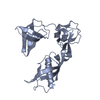
| ||||||||
| 2 | 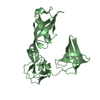
| ||||||||
| 3 | 
| ||||||||
| 4 | 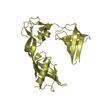
| ||||||||
| Unit cell |
|
- Components
Components
| #1: Protein | Mass: 23655.721 Da / Num. of mol.: 4 Source method: isolated from a genetically manipulated source Source: (gene. exp.)  Salmonella typhimurium (bacteria) / Strain: SJW1103 / Gene: flgA / Plasmid: PET22B / Production host: Salmonella typhimurium (bacteria) / Strain: SJW1103 / Gene: flgA / Plasmid: PET22B / Production host:  #2: Water | ChemComp-HOH / | Has protein modification | Y | |
|---|
-Experimental details
-Experiment
| Experiment | Method:  X-RAY DIFFRACTION / Number of used crystals: 1 X-RAY DIFFRACTION / Number of used crystals: 1 |
|---|
- Sample preparation
Sample preparation
| Crystal | Density Matthews: 2.4 Å3/Da / Density % sol: 48.83 % |
|---|---|
| Crystal grow | Temperature: 289 K / Method: vapor diffusion, hanging drop / pH: 4.2 Details: 12% PEG 6000, 0.05M CITRIC ACID PH 4.2, 1.0M LICl, 14% 2-METHYL-2,4-PENTANEDIOL, vapor diffusion, hanging drop, temperature 289K |
-Data collection
| Diffraction | Mean temperature: 100 K |
|---|---|
| Diffraction source | Source:  SYNCHROTRON / Site: SYNCHROTRON / Site:  SPring-8 SPring-8  / Beamline: BL41XU / Wavelength: 1 Å / Beamline: BL41XU / Wavelength: 1 Å |
| Detector | Type: RAYONIX MX225HE / Detector: CCD / Date: May 19, 2011 |
| Radiation | Monochromator: DOUBLE-CRYSTAL MONOCHROMATOR / Protocol: SINGLE WAVELENGTH / Monochromatic (M) / Laue (L): M / Scattering type: x-ray |
| Radiation wavelength | Wavelength: 1 Å / Relative weight: 1 |
| Reflection | Resolution: 2.3→40.8 Å / Num. obs: 39534 / % possible obs: 99.3 % |
| Reflection shell | Resolution: 2.3→2.42 Å / % possible all: 96.4 |
- Processing
Processing
| Software |
| |||||||||||||||||||||||||||||||||||||||||||||||||||||||||||||||||||||||||||||||||||||||||||||||||||||||||
|---|---|---|---|---|---|---|---|---|---|---|---|---|---|---|---|---|---|---|---|---|---|---|---|---|---|---|---|---|---|---|---|---|---|---|---|---|---|---|---|---|---|---|---|---|---|---|---|---|---|---|---|---|---|---|---|---|---|---|---|---|---|---|---|---|---|---|---|---|---|---|---|---|---|---|---|---|---|---|---|---|---|---|---|---|---|---|---|---|---|---|---|---|---|---|---|---|---|---|---|---|---|---|---|---|---|---|
| Refinement | Method to determine structure:  MOLECULAR REPLACEMENT / Resolution: 2.3→25 Å / Occupancy max: 1 / Occupancy min: 1 / FOM work R set: 0.7739 / SU ML: 0.86 / σ(F): 0 / Phase error: 29.71 / Stereochemistry target values: ML MOLECULAR REPLACEMENT / Resolution: 2.3→25 Å / Occupancy max: 1 / Occupancy min: 1 / FOM work R set: 0.7739 / SU ML: 0.86 / σ(F): 0 / Phase error: 29.71 / Stereochemistry target values: ML
| |||||||||||||||||||||||||||||||||||||||||||||||||||||||||||||||||||||||||||||||||||||||||||||||||||||||||
| Solvent computation | Shrinkage radii: 0.6 Å / VDW probe radii: 0.9 Å / Solvent model: FLAT BULK SOLVENT MODEL / Bsol: 60.642 Å2 / ksol: 0.4 e/Å3 | |||||||||||||||||||||||||||||||||||||||||||||||||||||||||||||||||||||||||||||||||||||||||||||||||||||||||
| Displacement parameters | Biso max: 143.44 Å2 / Biso mean: 60.0246 Å2 / Biso min: 5.08 Å2
| |||||||||||||||||||||||||||||||||||||||||||||||||||||||||||||||||||||||||||||||||||||||||||||||||||||||||
| Refinement step | Cycle: LAST / Resolution: 2.3→25 Å
| |||||||||||||||||||||||||||||||||||||||||||||||||||||||||||||||||||||||||||||||||||||||||||||||||||||||||
| Refine LS restraints |
| |||||||||||||||||||||||||||||||||||||||||||||||||||||||||||||||||||||||||||||||||||||||||||||||||||||||||
| LS refinement shell | Refine-ID: X-RAY DIFFRACTION / Total num. of bins used: 14
|
 Movie
Movie Controller
Controller




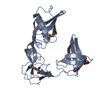
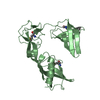

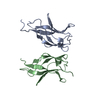
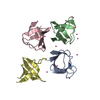

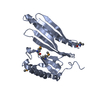
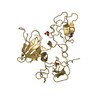
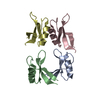
 PDBj
PDBj

